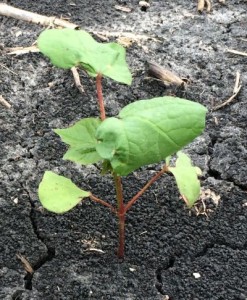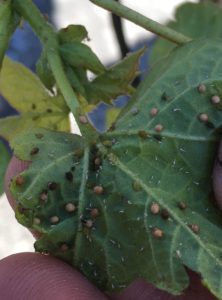The oldest cotton in the Mid-Coast is squaring and the youngest is just emerging from the ground. Pest management in early season is primarily focused on two or three insect pests: Thrips, Cotton Fleahopper and Aphids.
It is important to consider the pest, its numbers and the crop stage when deciding whether or not to add an insecticide to the tank. Even if it only costs $1, an unneeded tank partner will reduce crop profits.
Thrips can be a yield limiting pest until the cotton plants have 4-5 true leaves. While the published economic threshold is one thrips per leaf, this is intended to be used during environmental conditions that slow crop development such as cool temperatures under 60 degrees.
Current weather conditions do not favor thrips damage to cotton except in extremely high populations over 2-3 per true leaf. It is a rare field in South Texas that will profit from an insecticide treatment for thrips, especially if the cotton planted had an insecticide seed treatment.
Cotton Fleahoppers cause yield loss and delayed maturity by feeding on developing squares and causing them to fall from the plant. The damage window of the fleahopper is from 6 true leaves (squaring) to bloom.
Insecticides used prior to the 6-leaf stage will have little to no impact on the cotton fleahopper for several reasons. First, the insect is not often found in cotton prior to squaring. Second, if the fleahoppers are in cotton prior to squaring, they are not feeding on fruit and causing damage that would result in profit loss. Third, an inexpensive insecticide (less than $5 per acre) will not have more than 2-3 days residual control and will not prevent the need for another application if fleahoppers begin to immigrate into the field after 3 days.
Cotton aphids can often be found in cotton fields from emergence to harvest. When aphids are found in young cotton, they may cause alarm, but this is usually unfounded. In 25 years of looking at cotton, I have not seen a yield limiting population of aphids in cotton prior to bloom.
A suggestion I received several years back from Dr. Roy Parker was to mark places in a field where I find aphids and come back 2-3 days later to see if the population is growing or shrinking. This can save you from making an unnecessary insecticide application. This is certainly the case if you see more than 10-20% of the aphids mummified as in the picture above.
With crop prices low, it is important to cut unnecessary costs to help preserve profits. Early season insect pests may be one of these areas where savings can be found. Be sure and scout each field and manage the insects as they are found in their damage window.
29


